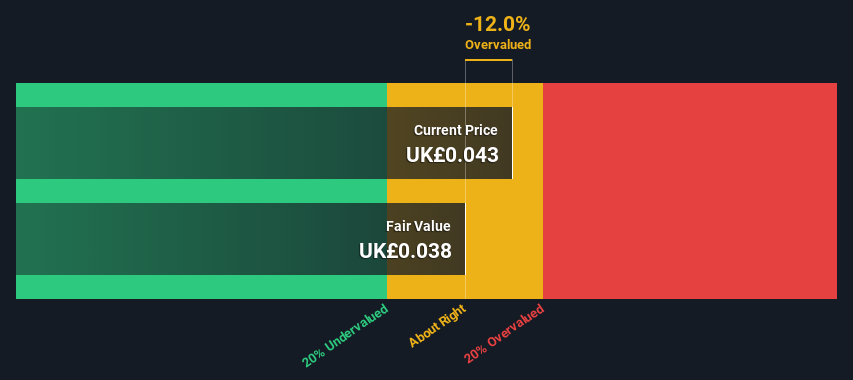- United Kingdom
- /
- Food and Staples Retail
- /
- LSE:DISP
Calculating The Intrinsic Value Of Zamaz plc (LON:ZAMZ)

Key Insights
- Using the 2 Stage Free Cash Flow to Equity, Zamaz fair value estimate is UK£0.038
- Current share price of UK£0.043 suggests Zamaz is potentially trading close to its fair value
- Zamaz's peers are currently trading at a discount of 44% on average
How far off is Zamaz plc (LON:ZAMZ) from its intrinsic value? Using the most recent financial data, we'll take a look at whether the stock is fairly priced by taking the forecast future cash flows of the company and discounting them back to today's value. We will use the Discounted Cash Flow (DCF) model on this occasion. Believe it or not, it's not too difficult to follow, as you'll see from our example!
Companies can be valued in a lot of ways, so we would point out that a DCF is not perfect for every situation. If you still have some burning questions about this type of valuation, take a look at the Simply Wall St analysis model.
See our latest analysis for Zamaz
The Method
We use what is known as a 2-stage model, which simply means we have two different periods of growth rates for the company's cash flows. Generally the first stage is higher growth, and the second stage is a lower growth phase. To begin with, we have to get estimates of the next ten years of cash flows. Seeing as no analyst estimates of free cash flow are available to us, we have extrapolate the previous free cash flow (FCF) from the company's last reported value. We assume companies with shrinking free cash flow will slow their rate of shrinkage, and that companies with growing free cash flow will see their growth rate slow, over this period. We do this to reflect that growth tends to slow more in the early years than it does in later years.
Generally we assume that a dollar today is more valuable than a dollar in the future, so we discount the value of these future cash flows to their estimated value in today's dollars:
10-year free cash flow (FCF) estimate
| 2024 | 2025 | 2026 | 2027 | 2028 | 2029 | 2030 | 2031 | 2032 | 2033 | |
| Levered FCF (£, Millions) | UK£1.23m | UK£1.27m | UK£1.29m | UK£1.32m | UK£1.34m | UK£1.37m | UK£1.39m | UK£1.41m | UK£1.43m | UK£1.45m |
| Growth Rate Estimate Source | Est @ 3.09% | Est @ 2.58% | Est @ 2.22% | Est @ 1.97% | Est @ 1.79% | Est @ 1.67% | Est @ 1.58% | Est @ 1.52% | Est @ 1.48% | Est @ 1.45% |
| Present Value (£, Millions) Discounted @ 6.1% | UK£1.2 | UK£1.1 | UK£1.1 | UK£1.0 | UK£1.0 | UK£1.0 | UK£0.9 | UK£0.9 | UK£0.8 | UK£0.8 |
("Est" = FCF growth rate estimated by Simply Wall St)
Present Value of 10-year Cash Flow (PVCF) = UK£9.8m
The second stage is also known as Terminal Value, this is the business's cash flow after the first stage. The Gordon Growth formula is used to calculate Terminal Value at a future annual growth rate equal to the 5-year average of the 10-year government bond yield of 1.4%. We discount the terminal cash flows to today's value at a cost of equity of 6.1%.
Terminal Value (TV)= FCF2033 × (1 + g) ÷ (r – g) = UK£1.5m× (1 + 1.4%) ÷ (6.1%– 1.4%) = UK£31m
Present Value of Terminal Value (PVTV)= TV / (1 + r)10= UK£31m÷ ( 1 + 6.1%)10= UK£17m
The total value is the sum of cash flows for the next ten years plus the discounted terminal value, which results in the Total Equity Value, which in this case is UK£27m. In the final step we divide the equity value by the number of shares outstanding. Compared to the current share price of UK£0.04, the company appears around fair value at the time of writing. Remember though, that this is just an approximate valuation, and like any complex formula - garbage in, garbage out.

Important Assumptions
Now the most important inputs to a discounted cash flow are the discount rate, and of course, the actual cash flows. If you don't agree with these result, have a go at the calculation yourself and play with the assumptions. The DCF also does not consider the possible cyclicality of an industry, or a company's future capital requirements, so it does not give a full picture of a company's potential performance. Given that we are looking at Zamaz as potential shareholders, the cost of equity is used as the discount rate, rather than the cost of capital (or weighted average cost of capital, WACC) which accounts for debt. In this calculation we've used 6.1%, which is based on a levered beta of 0.800. Beta is a measure of a stock's volatility, compared to the market as a whole. We get our beta from the industry average beta of globally comparable companies, with an imposed limit between 0.8 and 2.0, which is a reasonable range for a stable business.
SWOT Analysis for Zamaz
- Currently debt free.
- Current share price is above our estimate of fair value.
- ZAMZ's financial characteristics indicate limited near-term opportunities for shareholders.
- Lack of analyst coverage makes it difficult to determine ZAMZ's earnings prospects.
- Has less than 3 years of cash runway based on current free cash flow.
Moving On:
Although the valuation of a company is important, it is only one of many factors that you need to assess for a company. It's not possible to obtain a foolproof valuation with a DCF model. Instead the best use for a DCF model is to test certain assumptions and theories to see if they would lead to the company being undervalued or overvalued. For instance, if the terminal value growth rate is adjusted slightly, it can dramatically alter the overall result. For Zamaz, we've put together three fundamental factors you should further examine:
- Risks: Case in point, we've spotted 3 warning signs for Zamaz you should be aware of.
- Other High Quality Alternatives: Do you like a good all-rounder? Explore our interactive list of high quality stocks to get an idea of what else is out there you may be missing!
- Other Top Analyst Picks: Interested to see what the analysts are thinking? Take a look at our interactive list of analysts' top stock picks to find out what they feel might have an attractive future outlook!
PS. Simply Wall St updates its DCF calculation for every British stock every day, so if you want to find the intrinsic value of any other stock just search here.
New: Manage All Your Stock Portfolios in One Place
We've created the ultimate portfolio companion for stock investors, and it's free.
• Connect an unlimited number of Portfolios and see your total in one currency
• Be alerted to new Warning Signs or Risks via email or mobile
• Track the Fair Value of your stocks
Have feedback on this article? Concerned about the content? Get in touch with us directly. Alternatively, email editorial-team (at) simplywallst.com.
This article by Simply Wall St is general in nature. We provide commentary based on historical data and analyst forecasts only using an unbiased methodology and our articles are not intended to be financial advice. It does not constitute a recommendation to buy or sell any stock, and does not take account of your objectives, or your financial situation. We aim to bring you long-term focused analysis driven by fundamental data. Note that our analysis may not factor in the latest price-sensitive company announcements or qualitative material. Simply Wall St has no position in any stocks mentioned.
About LSE:DISP
Dispensa Group
Dispensa Group Plc, a consumer brands company, acquires, integrates, and digitizes food producers.
Good value with mediocre balance sheet.
Market Insights
Community Narratives



